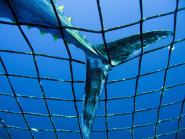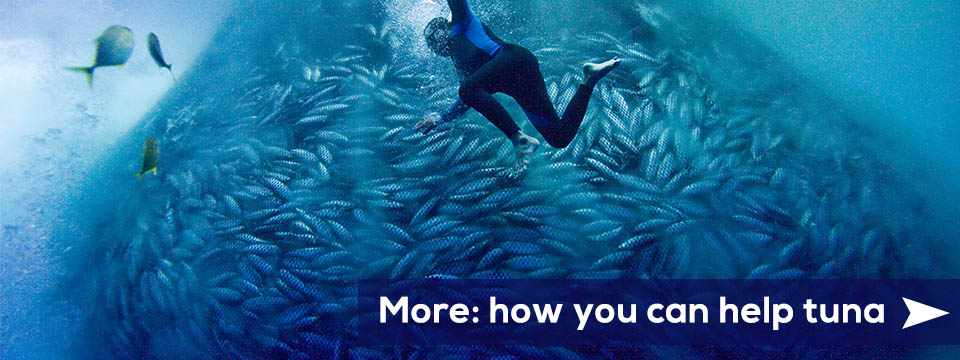
In 1999, Greenpeace recorded an 80 percentdecline in Mediterranean bluefin
And it's getting worse. Advances in technology mean that large ships - floating factories - are now able to take as much tuna in two days as whole countries can take in a year. Increasing practices of tuna ranching are further aggravating the crisis.
The true cost of tuna
The biggest tuna fishery in terms of volume is skipjack - the tuna most likely to end up in cans. While skipjack is not yet overfished, if fishing continues at current rates it won't be able to sustain itself. What's more, the methods used to net skipjack all too often catch young yellowfin and bigeye, threatening these species further. Yellowfin, a much more commercially valuable species, makes up 35 per cent of the world's catch. Today the majestic bluefin only represents 1.5 per cent of the landed volume of tuna, but its dollar value is astronomical. In 2001, a single bluefin tuna set an all time record when it sold for US$173,600 in Japan.
Numerous other marine species are hooked and netted in the global tuna fisheries. Around 100 million sharks, plus tens of thousands of turtles, are killed every year - causing devastation to the entire marine ecosystems.
Pirate fishing
Pirate fishing is also rampant in high value tuna fisheries, literally stealing tuna from the plates of some of the poorest people in the world. But even the legal tuna fisheries are part of the robbery. The so called "sweetheart deals" that fishing nations and rich multinational corporations negotiate with coastal states for access to fish tuna in their waters are incredibly unfair. Only around five per cent of the value of the tuna is given to the resource owners, often denying coastal communities much-needed employment and neglecting the responsibilities to fish responsibly.
We have the solution - Marine Reserves now!
Luckily, we have the solution - a network of marine reserves - national parks at sea: areas closed to all extractive uses, such as fishing and mining. These protected areas need to cover forty per cent of the world's oceans. Marine reserves provide a safe haven for marine life. And if they are properly designed to cover crucial breeding and spawning grounds, they also work for tuna and species that migrate over vast distances.
Marine reserves can help save tuna, ecosystems, and ultimately the fishing industry. After all, the fishing industry has a pretty miserable future if there's no fish left to, well, fish... If we want tuna tomorrow, we need marine reserves today.
Greenpeace is calling for the immediate closure of the Mediterranean bluefin fishery, until stocks recover - and for 40 per cent of the Mediterranean to be designated as marine reserves. In the Pacific, urgent measures including halving the amount of tuna taken, a ban on transferring fish at sea, and the creation of marine reserves in key areas of international waters must be taken to save the Pacific tuna fisheries and the tuna populations themselves from collapse.
Retailers must ensure they only sell legal, sustainable tuna
Supermarket retailers across the world from Norway to New Zealand and USA to Spain are being asked by Greenpeace to answer the hard questions: Where does our tuna come from? Is it sustainable? Is it caught from an area where developing countries are being ripped off? Is it stolen?
We are asking them to make sure that they know where their tuna originates, from boat to shelf, and commit to only sell tuna which is caught sustainably, by small-scale developing country fleets or under agreements which are fair to the people of the Pacific.



